When demand exceeds supply, customers feel a thrill like no other. The sense of exclusivity, urgency, and the satisfaction of securing a product that everybody wants creates the need to act quickly. Ask anyone who has awaited the release of a new PlayStation console or Apple product!

Here’s where pre-orders enter the game. Pre-ordering provides a fresh approach to product marketing. When executed correctly, you shouldn’t over-exaggerate your lack of stock or alarm your customers unnecessarily, a pre-order strategy can significantly benefit your business.
Readers Also Enjoy: [Infographic] How to Make a Strong Digital Marketing Strategy – DevriX
Moreover, and before you do anything, you need to take into account multiple factors if you want to take advantage of the pre-order strategy.
- What is the eCommerce pre-order?
- Benefits and disadvantages of offering pre-orders.
- The right moment to offer pre-orders.
- Pre-order methods.
- How do pre-orders work?
What Is an eCommerce Pre-order?
Pre-ordering is purchasing a product before it’s released or manufactured. It’s a clever sales strategy that encourages customers to pay upfront for an item that will be received at a future date..
And here’s the interesting part: you don’t have to invest in extra space (i.e. a warehouse or stockroom) to keep those items in stock! Plus, it’s a win-win situation because your customers have the freedom to reserve what they want in advance, without any concerns about items selling out, and you don’t need to rent or make room for additional stock.
eCommerce businesses love pre-ordering campaigns because they allow companies to offer their customers a lot of benefits or special rewards like free shipping.
What Is the Difference Between eCommerce Pre-order and Early Bird Offers?
Here, we need to distinguish between pre-orders and early bird offers. While they share the commonality of allowing customers to purchase a product before its release, there’s a big difference. With pre-ordering, customers can expect to receive the product shortly after its release, as there is a possibility that it may sell out quickly after becoming available. Early bird campaigns offer incentives to clients who choose to pay in advance, like booking a hotel months before their summer vacation.
Pros and Cons of Offering Pre-orders
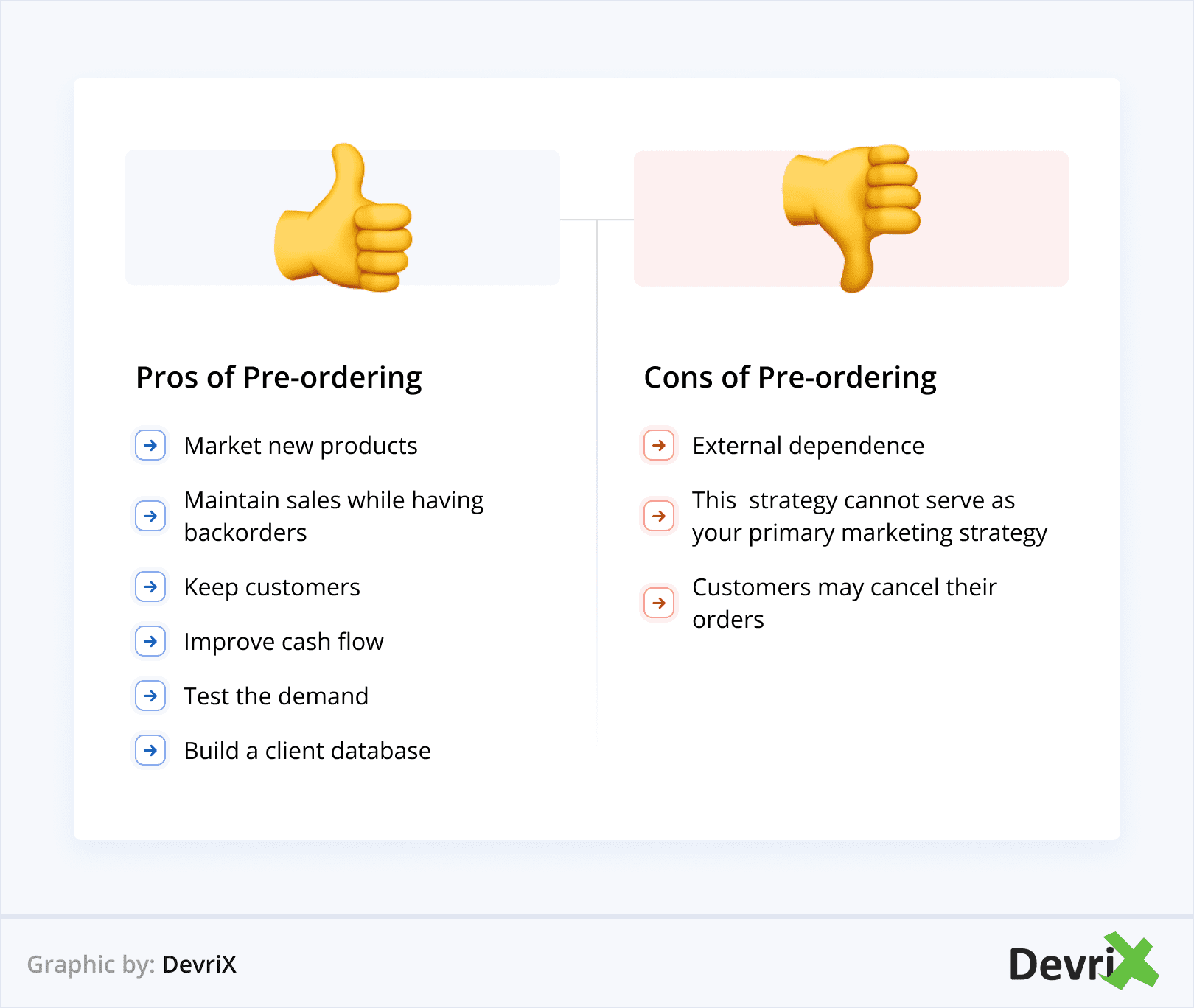
Pre-orders should be handled with care as they have the potential to tarnish the reputation of your eCommerce website if you fail to deliver or have too many items out-of-stock. Therefore, before incorporating this option into your online store, it is important to understand the benefits and drawbacks associated with it.
Pros of Pre-ordering
You should consider a pre-ordering button for a few good reasons. For instance, it: allows you to
- Market new products. You can promote new products before their launch by running pre-sale campaigns, just like game publishers do to generate interest.
- Maintain sales while having backorders. Pre-sales enable backorders, allowing you to continue making sales even when your inventory is at zero.
- Keep customers. Pre-orders make the waiting time easier by ensuring that your customers will receive the item as soon as it becomes available on your website.
- Improve cash flow. By accepting pre-orders, you can effectively manage cash flow during periods of financial and temporal investment.
- Test the demand. Pre-orders provide valuable insights into whether or not there will be demand for a specific product. Plus, they serve as a source of sales revenue.
- Build a client database. It is an excellent way to build an email list and establish connections with potential customers prior to the product launch. Also, having a database of interested customers can be a valuable asset for future marketing campaigns.
- Support creators. Crowdfunding platforms facilitate the connection between creators and individuals who wish to contribute to their ideas. Backers can anticipate receiving the product as soon as it is completed.
Readers Also Enjoy: How to Increase eCommerce Customer Retention [2023 Tips] – DevriX
Cons of Pre-ordering
Although pre-ordering can significantly boost sales, this technique does have its drawbacks.
- External dependence. You cannot offer pre-sales unless you are absolutely certain that your partners are fully prepared and capable of delivering your order on time, without any complications in the chain process.
- This strategy cannot serve as your primary marketing strategy. Running an online store only on pre-orders is not feasible. It is essential to have a variety of items readily available for customers to purchase.
- Customers may cancel their orders. There is always the option of ending up with unsold goods, especially if the pre-order option is excessively emphasized or pushed.
When Is the Right Time to Offer Pre-orders?

You may consider implementing pre-orders at any stage of your company’s development, but do keep in mind that your reputation hinges on delivering those goods on time. There’s no room for mistakes, as any slip-up could result in negative feedback that will likely spread like wildfire across social media.
Here are some tips on when to offer pre-orders:
- When you are launching a new product or service. This is especially true if you’re uncertain about how a product will sell and need to its gauge interest among your client base.
- When providing VIP clients with early access to limited-edition items.
By offering priority access to your most valuable customers, you can effectively incentivize customers to join your email list or loyalty program, fostering brand loyalty. - When you can combine pre-orders with discounts. When pre-orders are combined with discounts, it creates an even more enticing offer for customers.This strategy works very well when tied to a special occasion, holiday, or season.
Readers Also Enjoy: What Do Customers Want? 9 Things to Do Now – DevriX
Pre-order Methods
When offering pre-orders on your website, there are several payment schedules that you can offer.
Pay Now
By paying in advance, your customers are guaranteed that they will be among the first to receive the item once it becomes available. The Pay Now method is incredibly popular because it allows store owners to generate revenue even before the item is ready to be shipped. However, if you sell internationally, consider that some countries may have regulations against selling out-of-stock items.
Pay Later
The Pay Later pre-order method offers customers the convenience of reserving the desired items without the need for upfront payment. Customers can secure your product in advance and complete the payment at the time of shipping.
It’s a practical option that allows you to plan your finances accordingly while ensuring you don’t miss out on limited stock or popular releases. It is important that both parties retain the option to cancel the order if desired.
Crowdfunding
Customers often commit to sending money in advance through crowdfunding platforms, even if the product is not guaranteed, in exchange for rewards, equity, or other incentives. However, this is not a standard eCommerce approach.
How Do Pre-Orders Work: Essential Steps

Pre-ordering is a clear process of selling items your company doesn’t have yet, similar to dropshipping but on a smaller scale. This process involves a few standard steps:
Step 1: Establish Contracts
The initial step in pre-ordering is to establish contracts with your suppliers, ensuring a specified quantity of products on the day of release.
Step 2: Guide Your Customers
To provide guidance and establish proper expectations for your clients, you can create pre-order terms for your online store to outline the process and any relevant conditions.
Next, provide detailed information on how to place a pre-order, ensuring your customers understand the procedure. It’s also helpful to use unique labels and brief descriptions for pre-order items, distinguishing them from regular inventory.
Lastly, be sure to clearly indicate the expected delivery date, giving customers a clear timeline for when they can anticipate receiving their pre-ordered items.
Step 3: Create A Web Page
A pre-order web page typically includes key elements such as product details, anticipated release date, pricing information, a prominent pre-order button, and optional features like quantity selection and customer reviews.
Step 4: Make Placing a Pre-order Simple
Simplify the pre-order process by streamlining the steps. Optimize your website with clear product descriptions, intuitive navigation, and a prominent pre-order button. Offer multiple payment options and a secure checkout process. Provide transparent information about the expected release date and/or any potential updates as well as excellent customer support and easily accessible FAQs to address any concerns.
Step 5: Provide Pick-up and Delivery Options
Enhance the pre-order experience by offering convenient pick-up and delivery options that have been seamlessly coordinated between your team and customers for hassle-free experience. Make sure to clearly communicate any associated costs the different delivery options might incur. This way, customers can select the method that is most convenient for them.
Step 6: Spread the Word
It is time to make some noise. Leverage marketing strategies such as social media and influencer collaborations to promote your pre-order campaign. Use email marketing and optimized website content to reach and persuade potential customers to pre-order.
Step 7: Deliver
Ensure a positive pre-order experience by prioritizing and streamlining fulfillment, packaging and on-time delivery. Use sturdy packaging materials that protect the product during transit as well as regular updates and tracking information to keep customers informed. Promptly address any delivery issues or delays with responsive customer support.
Wrap Up
Pre-orders can generate early sales and positive customer engagement. However, careful planning and execution are necessary to avoid potential downsides such as inventory management challenges and customer cancellations.
By paying attention to details like prompt delivery and customer satisfaction, pre-orders can become a valuable tool for driving sales and fostering long-term success in the eCommerce industry.
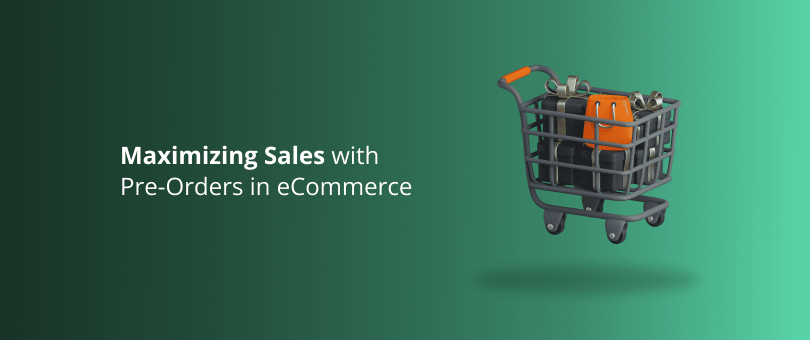
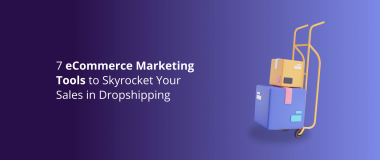
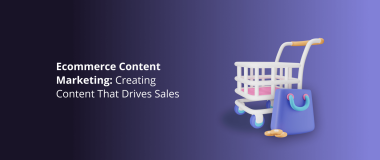
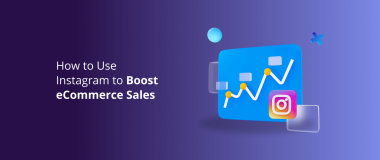
![16+ Tips on How to Increase eCommerce Sales [Expert Roundup]](https://devrix.com/wp-content/uploads/2020/02/16-Tips-on-How-to-Increase-eCommerce-Sales-Expert-Roundup-380x160.png)